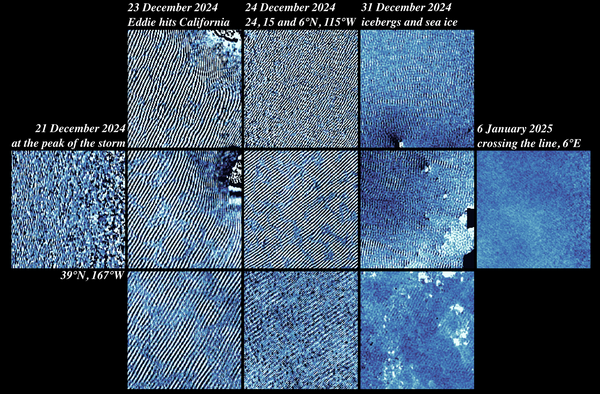Swot unveils how high ocean waves can be
Image of the Month - October 2025
![Map and highest wave heights of the 100 most severe storms from April 2023 to December 2024 (from [Ardhuin et al., 2025]). Top, Map of the 100 most severe storms from April 2023 to December 2024, with the tracks of the most severe storms plotted on top of the weaker ones. Storm tracks are provided by a numerical model and colored by time. Bottom, time series of modeled along the tracks [same colors as in (A)], and corresponding highest altimeter Significant Wave Heights (from [Ardhuin et al., 2025]).](/fileadmin/_processed_/3/7/csm_202510_pnas2513381122fig03_c61f592990.jpg)
Once upon a time, physicists considered that wave heights in the open ocean could not exceed 15 m, and attributed sailors' much higher estimates to a cultural tendency at exageration. Once instruments recorded wave heihgts, though, the truth turned out to be on the side of the seafarers. Satellite altimetry, in particular, have recorded wave heights over those 15 m on a regular basis - so much so that the extreme wave statistics for a 20-year return are around 17 m over the North Atlantic (see June 2011: Extreme wave heights). A record had been published in 2011 with Storm Quirin (see Apr. 2012: Phenomenal seas - note that it concerns unfiltered significant wave heights). However, it must be stressed that quite often no satellite would be measuring over the exact peak of a storm at its maximum - not even Swot swath -. Moreover, the highest local values found in the altimetry data need to be processed to take wave groups into account.
However, Swot enables to measure the swell from those storms ( see Oct. 2024: Swot & swell ). Since swell propagates over very large areas, radiating from the storm, and since Swot is observing it even with as low an amplitude as 3 cm, probability of measuring it is much higher than storm peak. From the swell, a team at LOPS (Ifremer, France) is going back to the initial storm's position and characteristics, including its maximum wave heights and period at its peak.
A record was thus pinpointed during a storm nicknamed Eddie, with a true maximum wave height between 19.7 and 20.2 m.
Continuing a systematic detection of swell and initial generating storm thanks to Swot will provide with a much in-depth knowledge of ocean wave properties. This should be useful in marine meteorology as well as ocean and coastal engineering, as well as in interpretation of ocean-generated seismic signals.
See also:
- Missions: Swot
- Applications: cyclones, typhoons and hurricanes
- Data: KaRIn L3_LR_WW product, developed by CLS/LOPS based on Ardhuin's publication
Other web sites on this topic:
- Swot reveals the largest ocean waves (LOPS web site)
- Swot reveals the largest ocean waves (Swot-Adac)
Reference:
- F. Ardhuin, T. Postec, M. Accensi, J. Piolle, G. Dodet, M. Passaro, M. De Carlo, R. Husson, G. Guitton, & F. Collard, Sizing the largest ocean waves using the SWOT mission, Proc. Natl. Acad. Sci. U.S.A. 122 (38) e2513381122, https://doi.org/10.1073/pnas.2513381122 (2025).


















